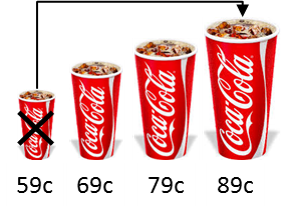
In 2006 VW CEO and Chairman came under fire (again) for the commercial failure of VW Phaeton. The car was conceived by the Chairman to compete against premium german brands of BMW and Mercedes and introduced in 2002, but it sold only 4000 units per year at a price of USD 100,000. Luckily, the VW Passat in the meantime grew substantially to 450,000 units per year at a price of USD 30,000, more than making up for the losses, but more importantly it turned out that these two events were not unrelated. What happened was that as VW Phaeton was introduced – priced at 3x the VW Passat and looking very much like an oversized VW Passat – customers suddenly had a much easier comparison point. It was no longer, should I get a small BMW, Mercedes or VW with all their different options, but simply should I get essentially the same car for USD 30,000 or USD 100,000 – a very easy choice for decision fatigued consumers.
This is the third article of five this time focused on the Product part of the classic 4P marketing parameters, where we take you through the insightful and fun world of Behavioural Marketing. You can read the previous articles here:
https://behaviouralstrategy.com/2016/06/01/taking-pricing-beyond-best-practice/ https://behaviouralstrategy.com/2016/05/25/behavioural-marketing-is-the-new-black/.
Context effects in product portfolios

VW is not the only company to use – knowingly or not – the consumers preference for simple comparisons and reason based choices. Did you ever wonder why there are always three sizes of coke in cinemas (and why they always seem to get bigger)? It is not because people have different preferences – by far most of the sales go into just one of the sizes. The reason is that humans actually rarely know what we want and if you simply present us with the size, that most prefer, then the choice becomes whether to have a coke or not, driving down sales. But by presenting three different options, our brains go: “well the big one is a bit expensive and I might run out too quickly with the small one, so…” – you guessed it – we almost always pick the middle one, which has been designed to deliver the highest profits. And over time to keep profits high and growing, the smallest is from time to time removed and exchanged with a new supersized one. This approach is incredibly important in designing your product portfolio particularly in consumer markets.
Quality perception

Lets face it: For the average person making hundreds of different sub category purchases in year, there is no time, expertise or sufficient interest to really dive into consumer reports, product reviews, company reputations etc. to really gauge the quality of the product. So what do we do? We turn to simply cues.You may remember the price-quality belief from https://behaviouralstrategy.com/2016/06/01/taking-pricing-beyond-best-practice/ and this is somewhat similar. Here is just a few fun examples:
- Today it is possible to manufacture completely silent vacuum cleaners. But when Miele tried to introduce this some years ago, sales were completely stagnant. Why? Because silent machines are perceived as weak machines and thus low quality!
- Cleaning liquid is almost always blue, because consumers fear other colors do not work as well – yep, we are all very rational.
- Listerine is one of the largest brands in the world within mouth wash. It has a terrible taste and you may remember when they tried to sell the nice tasting version some years back. But again people relate the terrible taste with the power to clean and it just never took off.
- Have you ever noticed how many of the shampoo brands are called something with “Silk”? It seems that this is what we want to think about, when pouring chemicals onto our body.
- If you have been to an Audi repair shop, you know they have been paying attention. It is whiter and cleaner than a surgery room, which is how people assess the quality of the service!
Tyranny of choice

We make 35,000 decisions in a day and obviously not all of them can involve complex decision making parameters and processes. You can wonder why, companies really think it makes sense to keep increasing complexity with brands, sub brands, categories, sub categories, flavors etc., driving up cost and making life difficult for their customers – We are not big fans of oversimplification, but here KISS (Keep It Simple, Stupid) may have a point. But there are some interesting variances: In a study selling jams two different tests were made with two different goals: When 24 jams were presented for tasting, 60% of shoppers would come to look, but only 3% would buy. When only 6 jams were presented, only 40% would look, but 30% would buy. So if you are looking to generate interest, more products work. But if you wants sales, then less is more!
Endowment effects and reciprocation

A chocolate bar is a chocolate bar and worth the same regardless of whether you own it or not, right? Wrong! Research show that when we take possession of something – even momentarily – the value we place on it increase significantly. In a famous study students were given a gift for completing a task. Some were given a chocolate bar, others a coffee mug and some were given the choice between the two – they had the same price. When suggested that they could trade, only 10% of each group wanted to trade, while the group that was free to chose, split 50/50, indicating that not only was the value indeed considered the same, but the groups had attached themselves to their gift.
There are lots of ways this can be used – here are some of the more benign ones:
- Ensure that customers are able to try products, increasing likelyhood to buy by 80%
- Free trials allowing customers to get used to owning it
- Loyalty program/coupon giving customers a right they are afraid to lose
- Credit with cash discount instead of cash with credit surcharge
Similarly, if you give your customers a gift, they will start valuing it beyond the actual price, but even better – if you are able to make it surprising and personal – they will reciprocate far beyond the value of the gift on average.
If you want to know more, feel free to read more about our methods or just reach out.
Leave a comment